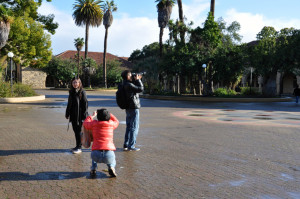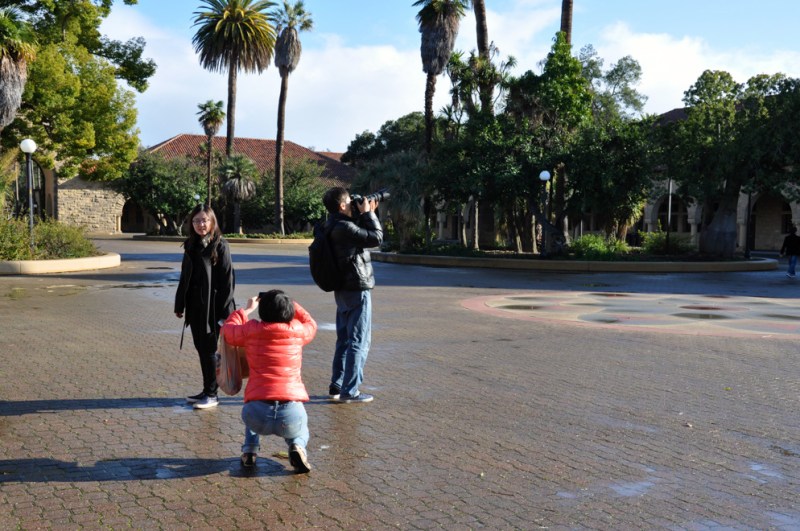Armed with selfie sticks, they congregate in the Oval, walk through the Main Quad and gaze upwards, through camera lenses, at the Hoover Tower. These visitors to campus tend to fall into one of two categories: prospective students and tourists. Both groups are on the rise.
Stanford has adapted to its rapidly growing number of visitors by expanding its tour programs and imposing stricter regulations on third-party tour groups.

Since the 2009-10 academic year, the number of registered Stanford tour participants has nearly doubled, from 58,000 annually to 99,000 in the 2014-15 academic year, according to Director of Visitor Relations DJ Dull-Mackenzie ’88. According to Dull-Mackenzie, this increased interest in Stanford reflects a dramatic increase in undergraduate applicants, from approximately 28,000 six years ago to an estimated 42,500 this year.
In response, the Visitor Center has increased both the number of tours and the types of tours that it provides, Dull-Mackenzie said.
“Currently, our staff ranges anywhere from 60 to 90 student guides to try to accommodate the needs,” he added, contrasting this to the approximately 15 student guides he remembered from his time as a student in the 1980s.
While the Visitor Center has adjusted to meet the needs of prospective students, it has had far more difficulty addressing those of large groups of tourists visiting campus. These tour groups are organized by third parties not affiliated with Stanford, and tend to visit Stanford as a part of a larger trip through the Bay Area.
“[There are] private tour operators who are making lots and lots and lots of money and there are hundreds of these tour operators based in different parts of the country bringing international groups here to see Silicon Valley, Stanford and San Francisco,” Dull-Mackenzie said.
Since the Visitor Center is a division of the Office of Undergraduate Admissions, Financial Aid and Visitor Information Services, its priority is to provide tours to prospective students, and it often cannot also accommodate these large tour groups.
As a result, the private tour operators who organize these trips find other tour guides who are knowledgeable about the University, according to Dull-Mackenzie.
“They either study it themselves or they hire people privately,” he said. “Sometimes they will even approach students if they feel that they have a contact. There are some high school students from the local community who have been recruited to give tours here, and even, in at least one or two cases, pose as Stanford students.”
When these tour groups arrive on campus, they tend to gather in the Main Quad, where faculty offices and classrooms are located. According to Dull-Mackenzie, many faculty members, especially those with offices near the Oval or Memorial Church, have been disrupted by tourists asking for directions or even taking pictures of faculty.
“I was frequently disturbed by large groups of tourists congregating outside my office windows,” wrote assistant professor of linguistics Dan Lassiter in an email to The Daily. “Sometimes they would take photos of me working.”
Recognizing the problems caused by third-party-led tour groups, Stanford has established various programs in recent years to address these complaints.
“We, by mandate of the entire University, the administration from the top down, have been asked to try… to control the problem of commercial tour groups on campus,” Dull-Mackenzie said. “There are strict limits on the number of groups that can come. You must have a permit now. It is highly regulated.”
In April 2014, the University began to require tour bus companies visiting campus to purchase permits for specific time slots between 6 a.m. and 6 p.m. This policy was a response to a Stanford census in 2013 reporting that the number of buses on campus had doubled over 18 months, to more than 50 buses a day.
This past August, the University instituted another policy requiring tour buses to park at Lasuen Street and Campus Drive, where there is only space for three buses and two vans. These buses and vans must pay steep rates of $200 an hour and $100 an hour, respectively, to park.
Parking and Transportation Services implemented these policies in response not only to faculty complaints but also to safety concerns about congestion in the Oval caused by tour buses. The department feels that these policies have been successful, according to Transportation Operations Lead Representative Danny Finale.
“While we haven’t tracked the exact number of complaints over time, we can say that disruptions in the Main Quad and the Oval have significantly decreased after the University relocated tour bus parking to Lasuen Street,” Finale said.
Lassiter also believed the parking regulations have been helpful.
“This problem has abated considerably since the University required tour buses to park farther away,” he wrote in an email to The Daily. “The limited tourist traffic I’m exposed to is not really a big nuisance anymore.”
Contact Blanca Andrei at bandrei ‘at’ stanford.edu.
An earlier version of this article incorrectly referred to DJ Dull-Mackenzie as female. The Daily regrets this error.
